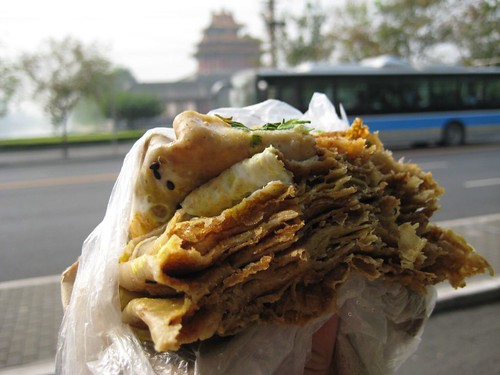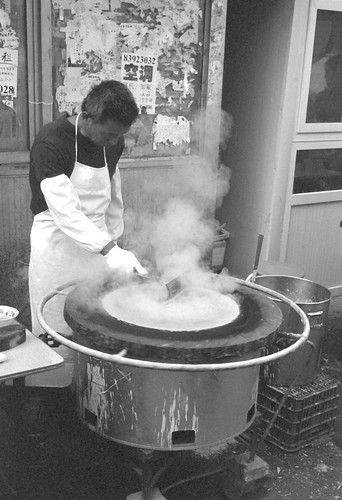Immediately following New Decade celebrations, I got two hours of sleep and went to the airport for a short vacation away from the bustle of Beijing.
The trip was one that Arnab put together to check out some small villages outside of Nanchang, in the southern Jiangxi province of the People’s Republic. They are Luotiancun, Shuinan and Jingtai.
View Larger Map
The vacationers included myself, Arnab, and his two Indian friends Swathish and Abhay. Our flight from Beijing to Nanchang was uneventful. I slept roughly the whole two-hour ride. Upon landing, we got a taxi to take us 30 km into Nanchang, and the ride was wild. There is no semblance of driving rules away from the major cities. Passing vehicles by driving into oncoming traffic is the norm down there, and no one goes faster because of it; gridlock is common on the smaller roads.
Arriving at the bus station at 11:30, we got a bus ticket for 14:00 to Anyi, the hub city from which we could reach the villages. In the meantime we ate a tasty and affordable lunch at a nearby restaurant, only about 23 kuai per person. As the only waiguoren (foreigners) in sight, we were stared at by everyone in the restaurant for a good ten minutes. On the way up the stairs, a girl who was coming the other way was heard to say “oh my God” in Mandarin when setting eyes upon our foreign visages.
We piled into the bus after waiting for about twenty minutes and a false start of getting onto the 13:50 bus. On the two-hour ride to Anyi I read a fair amount of The Razor’s Edge, an intriguing book Kelsey sent me.
At Anyi we got a taxi to take us to Luotiancun’s entrance. At the entrance there is a ticket office to get piao (tickets) for the stuff inside, but no one was on duty, so we were able to get in for free. The taxi driver was seemingly loathe to drive into the village because he was afraid he wouldn’t be able to turn around. He also talked to an old man on the road in the local dialect, which neither Swathish or Abhay (who understand Mandarin) could decipher.
We stepped out and started snapping pictures, as the light would only last another hour or so.





We walked up the main street in the village to see what we could. On the way we met a group of three students from Nanchang who were also staying the night in the village. My mates were taken with them, but we saw little of them for the rest of the trip.

The older village resident they were with directed us to a shop where we purchased a local batch of their honey liquor for the weekend’s enjoyment. It tasted pleasant, like a mix between port wine and brandy. The Chinese name for it escapes me, unfortunately.

We secured a room at the largest boarding house in the town, on the main square opposite the large pool. They served us dinner, which was tasty but overpriced due to a chicken costing 70 kuai. Nonsense! They were walking around the whole village like they owned the place. Surely a chicken could be had for 35 kuai or less. Oh well – you have to get ripped off somehow.

We spent the evening playing cards and drinking the honey wine and some beer. Nothing goes on in the village at night. Also, southern China has a tradition of no indoor heating and leaving the windows open even in the cold. Add in the higher humidity and a minor vacation from the stabbing dry frigidity of Beijing becomes only marginally more tolerable wet cold. We shut our windows and after thirty minutes or so our four bodies warmed the room up a bit. We went to bed at about ten o’clock, knowing that we would be waking up with the village between five and six. The blankets they gave us did wonders for me; after about five minutes I could feel my body heat radiating back towards me and I slept soundly. The others tossed and turned all night with the cold.


At six the next morning we were out wandering the village and taking pictures. Villagers were lively at this hour. We took our time enjoying what charm was left in Luotiancun, obviously both a benefactor and victim of foreign tourism and the investment of the government. The old rough-hewn stones which made up some of the footpaths were being replaced by gray bricks, and poured concrete shared space with pre-Communist houses. But Luotiancun’s layout and lifestyle were a welcome vacation from Beijing. Abhay and I went together while Swathish and Arnab paired up at a different pace.



The tree and the old mansion were my favorite parts. High on the list was the two kuai noodle breakfast when I shared a table with two women who were at least eighty years old, and the children who screamed and fled whenever I pointed the camera at them.

Between Luotiancun and the next village, Shuinan, there is a nice 500 meter long pathway that is a part of the old trade road in the area. A few people were working in the tiny farm plots, and at the end we saw a buffalo.

In Shuinan, Abhay and I caught a short but interesting episode: the duck parade.



The old man who was herding these hundreds of ducks got irate at us for standing in the way of his charge and snapping photos. It was a phenomenon we could not miss though; just thirty seconds after the sound of many webbed feet padding against the pavement began, the last delicious-looking bird waddled out of sight.



The rest of the village trip, all thirty minutes of it, was unremarkable. The old charm of Shuinan and especially of Jingtai, the last village, had been rudely uprooted and replaced by filthy, sad poured concrete and dirt runoff. Luotiancun alone retained enough of its old style to be worth the trip.
We got a taxi back to Nanchang, which was much faster and more direct than the bus would have been. We made it into the city in time for lunch, and we spent the rest of the afternoon on a short trip into the Buddhist temple and in a museum dedicated to the Nanchang Revolt. There was plenty of propaganda to go around there.
The evening consisted of a subpar dinner and playing more cards and drinking more honey wine; there wasn’t much desire to head out and party because our flight was to take off at 08:30 the next morning.
However, when we got in the taxi at 06:00 it was so foggy that a three meter visibility plagued us the whole 30 km to the airport, and the main road was shut down so the driver had to use a poorly maintained local road to get there. Our flight was of course delayed, not only because of the pervasive fog in Nanchang but because Beijing was experiencing its worst blizzard in 50 years. We whiled away the time slowly drinking overpriced coffee and beer and playing more cards. I noticed a foreign girl sitting lonely by herself in the airport and invited her to play with us. She was a Polish girl named Tosha who teaches blind and deaf children in Rome, and she was headed to Beijing as well to visit a friend. The plane boarded us at noon, but it was only to serve us lunch; we weren’t able to get out of Nanchang until 17:00 that day. After touching down in Beijing (whew!), the flight board showed that about nine out of ten flights to and from the capital were cancelled. Lucky us.
At the gate to the airport express train, the way had been shut by the police due to too many people trying to get through. After a while ten officers marched up and prepared to open the gate just enough to let a slow stream of people through, but in true Chinese fashion the crowd pressed their way hard and consequently forced the gates open wider and wider. Even with heavy police effort to shut the gate more, the opening would slide open on one side while it slid shut on the other. One man almost got into a fight with a police officer. It was kind of exciting.
The trip was worth it overall even though it wasn’t terribly packed with village exploits. Even what small time was had was a respite to the soul. Now I have mine and Kelsey’s trip to Laos and Cambodia in February to look forward to. There the weather will be truly warm!


























































